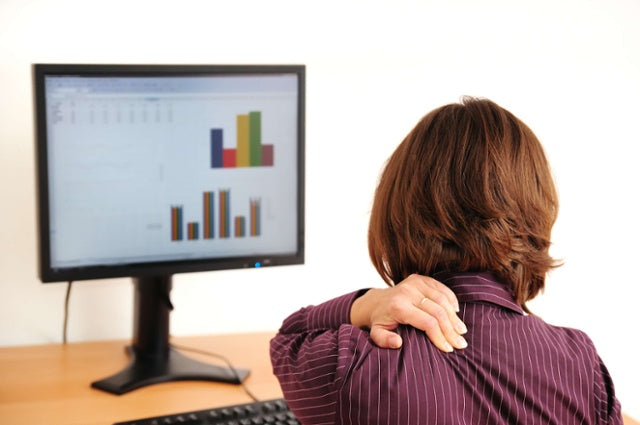
The True Cost of Buying the Wrong Desk
The True Cost of Buying the Wrong Desk
When it comes to our health, everyone has made a trade-off at some point. Whether it was eating a second donut or losing sleep to your favorite show, we all find a reason to justify an unhealthy behavior every now and then.
But what if you knew more health issues will arise because you purchased the wrong desk?
No one wants to be bedridden because of back and hip pain or forced to monitor insulin levels because of diabetes, but by sitting at a desk for prolonged periods of time, you're putting yourself at risk for more than that.
The cost of the wrong desk is more than a number on your bank statement and with adults spending an average of 50-60% of their day sedentary, the health effects are proving to be disastrous. The worst, and best, part is that you can change it just by standing.
Standing for a Healthier Life
While it may feel great to take a load off after a long day, many people aren’t spending that day on their feet to begin with. Though it may not seem logical, if you were to stay on your feet, you would actually have more energy for whatever you have going on with the rest of your day.
Sitting is a silent killer. By remaining sedentary for long periods of time, your posture causes back and neck problems, weight gain, increased risk for heart disease and diabetes, and an extensive list of other problems.
The worst part is that no matter how active you are, even if you’re getting the recommended amount of exercise daily, you can’t undo the damage from sitting. Dr. Genevieve Healy of the University of Queensland in Australia is a metabolic researcher who’s found that extremely active individuals are still “high risk” if they’re sitting more than 6 hours a day.

The Physical Costs
The reason your hands and feet have thicker skin is because those are the few body parts that make contact with nature. Your feet are soled to protect them from the ground while your hands are prepared to grab whatever is necessary.
Notice that thicker skin doesn’t cover your hamstrings.
Sitting in chairs, while a comfortable respite, was never meant to be on mankind’s to-do list. Chairs are an advancement that are setting us back at a devastating cost.
Back and Neck Pain

Part of the sitting issue spawns not only from sitting but from the type of chair you’re using. If it’s heavily padded, you run the risk of more injury.
The human body is designed to release into gravity. As you sit, your bones come together in a special arrangement that stops them from compressing uncomfortably. They can only achieve that position if they’re able to fully release. A cushion stops your skeletal structure along the way, forcing muscles and tendons to strain.
This is what causes a majority of back pain. Your vertebrae are compressing in a manner they’re not designed to. Your back will arch or conform to the chair, displacing discs.
Your neck is affected in the same way. Without proper training or conscious effort, you’ll find your neck craning forward towards the workload on your desk. When you’re standing, your neck maintains a neutral position, avoiding that injury.
Muscular Atrophy
This can be counteracted, but depending on your level of sedentariness, you risk having your muscles waste away. Without use, the muscle groups that support you for balance and natural movement become secondary organs. Your brain is triggered to send resources to where they could be better used, meaning no six pack and weaker back.
Couple that with your body’s inability to release into gravity and you’re running a higher risk for back problems.
The Physiological Costs

Along with your muscles and skeletal structure being affected, your body undergoes different chemical reactions caused by the “sitting disease”.
Weight Gain
Aside from the obvious lack of calorie burn from sitting, there are a series of other processes that are happening when you’re not standing. These are what cause metabolic syndrome.
The enzyme lipoprotein lipase (LPL) is important to the transportation and use of fats in your body, mainly in the form of triglycerides. They’re what determine what to do with the fat from your diet.
When you’re active, LPL burns the fat, but when you’re sitting, it gets stored in your reserves. This is the main reason for weight gain. As you start exercising, your body has to burn through the fat that hasn’t been stored before touching the excess.
As long as you’re on your feet, your body will sense that it needs to use that energy, causing it to hold on longer before storing it.
Current studies are investigating how closely LPL is tied to your circadian rhythm. If they are closely correlated, your body will fall into a routine of storing fat daily until you break the habit and start standing.
Diabetes
A study by the University of Missouri-Columbia found a direct correlation between time sedentary and type 2 diabetes.
Their research claims one hour of time sitting increased the prevalence of metabolic syndrome by up to 26%. It also states that the one hour has a negative impact similar to the positive impact of 30 minutes of exercise.
Dr. Emma Wilmot and a team from the University of Leicester in England completed 18 studies with nearly 800,000 people that showed those who sat for the longest amount of time were twice as likely to have diabetes or heart disease compared to individuals who sat the least.
Heart Disease
Martha Grogan, a Cardiologist with the Mayo Clinic, claims, “For people who sit most of the day, their risk of heart attack is about the same as smoking.”
Studies have shown that being sedentary changes the neuronal structure in the parts of the brain associated with cardiovascular regulation, increasing the risk of heart disease.
With the impact from LPL, arteries become clogged as the body continues to store fat rather burning it. This drastically increases risk and takes significantly longer to undo the damages than to create them.
Early Death
All of these factors compound, increasing the chances of premature death. The American Journal of Epidemiology conducted a study that showed sitting more than six hours a day raises your risk of early death.
This is the time when you start asking yourself how much that chair is really worth.
The Mental Effects
Your brain is dependent on blood flow in order to function. That’s common knowledge, but too few people understand that sitting compromises your brain’s abilities.
Like with the health risks, LPL plays a large role. The fat that clogs your veins will reduce blood flow, but that also means your brain doesn’t receive all of the hormones and oxygen it needs. This contributes to a lack of focus, energy, and an increased risk for mental illness.
Studies have found that individuals who spend more than 6 hours of their work day seated are more likely to suffer from psychological stress than those who sit for less than 3.
A separate study even saw that people who sat for around 7 hours a day were significantly more apt to face depression. Their recommendation? Get on your feet to stay active and curb your potential for the illness.
Standing for a Cause
These stats aren’t meant to strike fear, but the startling truth is that sitting too much can lead to more problems than it’s worth. Standing is your body’s natural position and it only takes a few days to see dramatic effects from switching to your feet.
The norm is set, but going against it can bring you an enormous number of benefits. With people spending up to eight hours a day at a desk, there's never been an easier way to change your life for the better and after a short time standing at the right desk, you’ll find improved focus, weight loss, and many aches and pains disappearing.
The cost of buying the wrong desk is more than a monetary value. It's a choice that can destroy your mental, physical, and emotional health. When you see the benefits and detriments of your decision as more than a price tag, you'll realize that it's worth every penny.
If you need more information on why a standing desk is better for you, check out these articles about the positive effects a standing desk can have and see the hundreds of other reasons why you should get one now.

